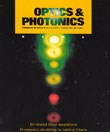
January 1991 Issue
Feature Articles
HDTV: Tuning in or Fading out?
A surgeon in Bangkok, puzzled by a tumor on his patient's liver, beams a picture of the tumor to a team of experts in San Francisco via a high resolution transmission system and waits for their diagnosis. Because of the real-life clarity of the picture, the San Francisco team can prescribe the best course of action and transmit the information to Bangkok in a matter of minutes. The high resolution, true rendition of color, and interactive capabilities of advanced video communications technologies promise to have profound implications for education, entertainment, medicine, telecommunications, and other fields.
by Susan M. ReissThe mystery of frequency doubling in optical fibers: Seeing glass in a new light
In the fall of 1985, two graduate students at the Royal Institute of Technology in Sweden were launching intense infrared light pulses from a Nd:YAG laser operating at 1.064 μm into a standard telecommunications fiber. Embarked on a program" to investigate nonlinear optical phenomena in fibers, these young researchers chanced upon one of the most curious of all nonlinear optical effects—an effect that is still largely unexplained.
by Victor Mizrahi and J.E. SipeCaught between standards: One solution
A recent phone call from a small firm about to prepare some optical drawings got me thinking about the problem of future conversion to the new international optical drawing standard, ISO 10110. The gist of the call was that the company had prepared few, if any, optical drawings. What standard should they follow? Since the new ISO standard is nearly finished, would it make sense to start using it now?
by Robert E. ParksIn this article, we discuss the power of the compound eye. It is clear that the eye of an insect is able to detect the movement of an enemy or prey, as well as patterns of light and dark areas. But this equipment would not seem to give an insect a clear, sharply defined image of the external world. Of course, we do not know that what we see is any more real than what insects see. The signals conveyed to our brains produce certain instinctive reflex actions—we may turn away or close our eyes. By more complicated mental processes, visual memory influences visual perceptions. Insects react by visual memory: for example, returning to a nest and using visual landmarks.
by Marge Elwell and Lisa WenErbium-Doped Fiber Amplifiers for New Generations of Optical Communication Systems
From these pioneering times to now—where this basic principle of optical amplification made it possible to demonstrate optical communications at multi-gigabit rates through distances over 2,000km (ref.2) and potentially 10,000km (ref. 3)—a considerable evolution in technology has taken place. Following the invention and development of the first lasers and GaAs laser diodes (1958-1962), the idea of doping glass fibers with rare-earth ions for achieving traveling-wave amplifying devices was soon investigated. In 1963, C.J. Koester and E. Snitzer (himself inventor of glass lasers) obtained 47 dB gain at 1.06 μm wavelength, using a 1m-long neodymium-doped fiber coiled around a flash lamp.4 After the demonstration of low-loss single mode fibers by Corning in 1970, nonlinear effects such as stimulated Raman (SRS) and Brillouin (SBS) scattering were also shown to offer the potential for light amplification (R.H. Stolen and E.P. Ippen, 1972).
by E. Desurvire

![Manual probe system with needles for test of semiconductor on silicon wafer. [A. Morozov / Getty]](https://opnmedia.blob.core.windows.net/$web/opn/media/images/articles/2025/1125/departments/202511-cover-web.jpg?ext=.jpg)
![Researcher Clara Saraceno in the lab. [Image by Carsten Behler Photography]](https://opnmedia.blob.core.windows.net/$web/opn/media/images/articles/2025/1025/departments/202510-cover-web.jpg?ext=.jpg)
